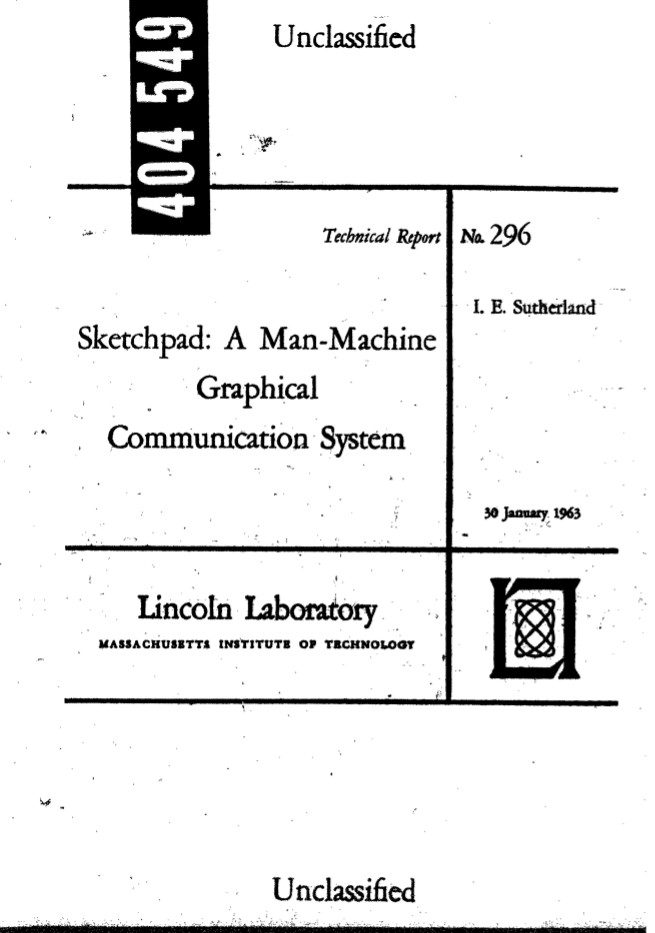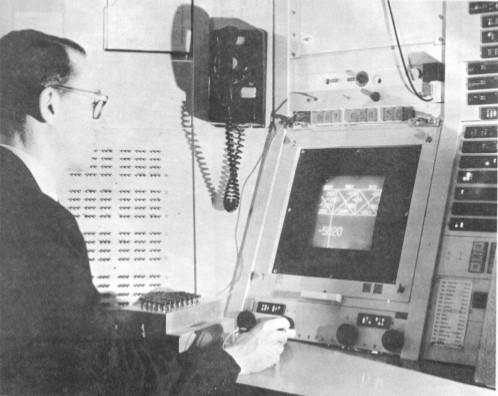Ivan Edward Sutherland: Sketchpad: A Man-Machine Graphical Communication System (1963/2003)
Filed under thesis | Tags: · computing, design, drawing, interface, software, technology


This technical report is based on a dissertation submitted January 1963 by the author for the degree of Doctor of Philosophy to the Massachusetts Institute of Technology.
“The Sketchpad system uses drawing as a novel communication medium for a computer. The system contains input, output, and computation programs which enable it to interpret information drawn directly on a computer display. It has been used to draw electrical, mechanical, scientific, mathematical, and animated drawings; it is a general purpose system. Sketchpad has shown the most usefulness as an aid to the understanding of processes, such as the notion of linkages, which can be described with pictures. Sketchpad also makes it easy to draw highly repetitive or highly accurate drawings and to change drawings previously drawn with it. The many drawings in this thesis were all made with Sketchpad.
A Sketchpad user sketches directly on a computer display with a ‘light pen.’ The light pen is used both to position parts of the drawing on the display and to point to them to change them. A set of push buttons controls the changes to be made such as ‘erase,’ or ‘move.’ Except for legends, no written language is used.
Information sketched can include straight line segments and circle arcs. Arbitrary symbols may be defined from any collection of line segments, circle arcs, and previously defined symbols. A user may define and use as many symbols as he wishes. Any change in the definition of a symbol is at once seen wherever that symbol appears.
Sketchpad stores explicit information about the topology of a drawing. If the user moves one vertex of a polygon, both adjacent sides will be moved. If the user moves a symbol, all lines attached to that symbol will automatically move to stay attached to it. The topological connections of the drawing are automatically indicated by the user as he sketches. Since Sketchpad is able to accept topological information from a human being in a picture language perfectly natural to the human, it can be used as an input program for computation programs which require topological data, e.g., circuit simulators.
Sketchpad itself is able to move parts of the drawing around to meet new conditions which the user may apply to them. The user indicates conditions with the light pen and push buttons. For example, to make two lines parallel, he successively points to the lines with the light pen and presses a button. The conditions themselves are displayed on the drawing so that they may be erased or changed with the light pen language. Any combination of conditions can be defined as a composite condition and applied in one step.
It is easy to add entirely new types of conditions to Sketchpad’s vocabulary. Since the conditions can involve anything computable, Sketchpad can be used for a very wide range of problems. For example, Sketchpad has been used to find the distribution of forces in the members of truss bridges drawn with it.
Sketchpad drawings are stored in the computer in a specially designed ‘ring’ structure. The ring structure features rapid processing of topological information with no searching at all. The basic operations used in Sketchpad for manipulating the ring structure are described.” (from the Abstract)
PhD thesis
Originally submitted at the Massachussets Institute of Technology, January 1963
Technical report published by University of Cambridge, September 2003
New preface by Alan Blackwell and Kerry Rodden
ISSN 1476-2986
149 pages
Sketchpad presentation with comments by Alan Kay (video)
PDF (original thesis, 1963)
PDF (2003 edition)
Edward Tufte: Beautiful Evidence (2006)
Filed under book | Tags: · data visualisation, design, graphic design

Science and art have in common intense seeing, the wide-eyed observing that generates empirical information. Beautiful Evidence is about how seeing turns into showing, how empirical observations turn into explanations and evidence presentations. The book identifies excellent and effective methods for presenting information, suggests new designs, and provides tools for assessing the credibility of evidence presentations.Here we will see many close readings of serious evidence presentations-ranging through evolutionary trees and rocket science to economics, art history, and sculpture. Insistent application of the principles of analytical thinking helps both insiders and outsiders assess the credibility of evidence.
Publisher Graphics Press, Cheshire/CT, 2006
ISBN 0961392177, 9780961392178
213 pages
review (Stephen Few, BeyeNetwork)
review (Yuri Engelhardt, Information Design Journal)
PDF (no OCR, updated on 2013-2-2)
Comments (2)Paul Betts: The Authority of Everyday Objects: A Cultural History of West German Industrial Design (2004)
Filed under book | Tags: · aesthetics, bauhaus, cold war, design, germany, industrial design, weimar republic

From the Werkbund to the Bauhaus to Braun, from furniture to automobiles to consumer appliances, twentieth-century industrial design is closely associated with Germany. In this pathbreaking study, Paul Betts brings to light the crucial role that design played in building a progressive West German industrial culture atop the charred remains of the past. The Authority of Everyday Objects details how the postwar period gave rise to a new design culture comprising a sprawling network of diverse interest groups—including the state and industry, architects and designers, consumer groups and museums, as well as publicists and women’s organizations—who all identified industrial design as a vital means of economic recovery, social reform, and even moral regeneration. These cultural battles took on heightened importance precisely because the stakes were nothing less than the very shape and significance of West German domestic modernity. Betts tells the rich and far-reaching story of how and why commodity aesthetics became a focal point for fashioning a certain West German cultural identity. This book is situated at the very crossroads of German industry and aesthetics, Cold War politics and international modernism, institutional life and visual culture.
Publisher University of California Press, 2004
Weimar and Now: German Cultural Criticism Series
ISBN 0520240049, 9780520240049
348 pages

